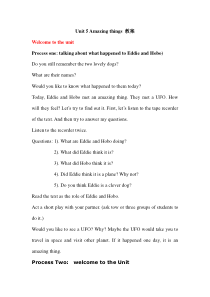 DOC
DOC
【文档说明】《Unit 5 Amazing things Welcome to the unit》教学设计8-七年级下册英语【牛津译林版】.doc,共(16)页,77.000 KB,由小喜鸽上传
转载请保留链接:https://www.ichengzhen.cn/view-102417.html
以下为本文档部分文字说明:
Unit5Amazingthings教案WelcometotheunitProcessone:talkingaboutwhathappenedtoEddieandHobo)Doyoustillrememberthetwolo
velydogs?Whataretheirnames?Wouldyouliketoknowwhathappenedtothemtoday?Today,EddieandHobometanamazingthing.TheymetaUFO.H
owwilltheyfeel?Let‟strytofindoutit.First,let‟slistentothetaperecorderofthetext.Andthentrytoanswermyquestions.Listentotherecordertwice.Question
s:1).WhatareEddieandHobodoing?2).WhatdidEddiethinkitis?3).WhatdidHobothinkitis?4).DidEddiethinkitisaplane?Whynot?5).DoyouthinkEdd
ieisacleverdog?ReadthetextastheroleofEddieandHobo.Actashortplaywithyourpartner.(asktoworthreegroupsofstudentstodoit.)Wouldyouliketose
eaUFO?Why?MaybetheUFOwouldtakeyoutotravelinspaceandvisitotherplanet.Ifithappenedoneday,itisanamazingthing.ProcessTwo
:welcometotheUnitActuallytherearelotsofamazingthingsintheworld.Herearelotsofsurprisingthings.Forexample:1).Doyouknowifplantscangrowwith
outthelightning?2).DoyouknowhowlongittakestotravelfromtheEarthtothemoon?3).Doyouknowifyoucansneezeandopenyoureyesatthesametime?4)
.Doyouknowwhoisthetallestmanintheworld?5).Doyouknowhowtheelephantswalk?6).Doyouknowifthefishcloseeyes,whenitissleeping?DotheexercisesonP5
7.ChecktheanswersProcessThree:Explainsomeimportantlanguagepoints.Dosomeexercises.ProcessFour:talkingaboutamazinganimalsIknoweveryone
ofyoulikeanimals.Someofyouhavepetsinyourfamily.Therearealsosomethingamazingaboutanimals.Listentomyquesti
onsandcanyoufindoutwhichanimalitis?1).Doyouknowwhichisthemostdangeroussnakeintheworld?2).Doyouknowwhichbirdcanstayintheairwithoutmoving?3).Doyouk
nowwhichdogisthesmallest?4).Doyouknowwhichanimalisasoldasdinosaur?5).Doyouknowwhichanimalisascleveraspeople
?6).Doyouknowwhichanimalcanliveforamonthwithouthavingwater?7).Doyouknowwhichanimalisthebiggestintheworld?8).Doyoukno
wwhichanimalisthemostdangerousinthesea?9).Doyouknowwhichanimalhasthelongestneck?Nowlet‟stalkaboutamazingthingswiththef
ollowingpattenDoyouknowif…?(Doyouknowthat/which..?)---Oh,really?---Isn‟tthatinteresting?(amazing,funny,great,interesting,st
range,wonderful,surprising,cool…)---Yes,itis.Doyouknow.(Sorry.Idon‟tthinkso.)askthestudentstopreparethedialogueandactitout.Reading1单元Un
it4课题Reading1课时日期教学目的TointroducethestyleoftheghoststoryToidentifyspecificmeaningbyscanningthetextTopredictmeaning
ofspecificwordsfromcontext教学重点、难点教学过程Lead-in1.AskSstolistentothetapeofthetext,thentrytoanswerthefollowingquestions:a.WheredidMilli
eandAmygo?When?b.WhatdidMillieandAmyhear?c.Howdidtheyfeel?Didtheyrunaway?d.Wheredidthewhispercomefrom?
e.WhatdidAndyfindatlast?2.GetsomeSstoretellthestorytoseeiftheycatchthemeaning.Presentation1.Explainthetextlinebyl
ine.2.Languagepoints:a.asusualeg),LastSunday,MrWangwentfishingasusual.b.distinguish„whisper,sound,noise,andvoice‟whisperv&ne
g)XiaoWangwhisperedsomethinginXiaoMing‟sear.Maryspokeinawhisper.Soundn&vEg)Canyouhearthesoundofthepiano?Itsoundsgreat.NoisenEg)Don‟tmak
eanynoisesintheclassroom.VoicenEg)MsWuhasasweetandsoftvoice.3.frightened&afraidbefrightenedeg)Don‟tbefrightened.
Afrightenedgirliscrying.Beafraid(that)BeafraidofsthEg)Sheisafraidofsnakes.BeafraidtodosthEg)Iamafraidtojumpintothewater.4.onone‟sw
aytoaplaceontheirwaytoplace5.saytooneself6.takecareof=lookafter7.not….anymore=not……anylonger=nolongereg)Iamnotafraidoftigersanymore.=Iamnotafraido
ftigersanylonger.=Iamnolongerafraidoftigers.教学后记单元Unit4课题Reading2课时日期教学目的TosummarizekeypointsofastorybysequencingstatementsToidentifykeyevents
andinfergeneralmeaningTodotheexercisescorrectlyandreadthetextfluently教学重点、难点教学过程1.AskSstoreadthetextafterme,thengivethemsomeminu
testoreaditbythemselves.2.GetSstodopartB1(p59)individuallyandchecktheanswers.Payattentiontothefollowing
points:A.awhisper=asoftnoiseB.weak=notstrongC.takecareof=lookaftereg)Ishouldtakecareofmymothertoday.=Ishouldlookaftermymothertoday.D.thefollow
ingSunday=thenextSunday3.AskstudentstofillintheblanksinpartB2,thenreadtheconversationtogether.Letsomestudentsspeakouttheiranswersandcheckit.Theim
portantpointsareasfollowing:A.runawayeg)Whentheyheardthestrangenoise,theyranawayquickly.B.soundlikeaghostC.t
heanimalcenter4.GetSstoretellthestory,thatistorepeatthemainplothappenedinthetext.Afterthataskstudentstoseeifthesentencesinpartc1arer
ightandexplainthereasonofthewrongs.Thepointsareasfollowing:A.beexcitedeg)IwasexcitedwhenIheardthenew
s.B.thetopofthebigtreeonthetopofthehillC.helpsbdosth5.Letstudentsputthesentencesintothecorrectorder,thenaskthemtoreadthecorrectanswe
rs.6.Askstudentstodotheexercisingpaper,meanwhilepayattentiontothefollowingpoints:care(adj)--carefully(adv)somebody-----anybodyusual-----
unusualnot---anylonger=not----anymorehaveagreattime=haveagoodtime=enjoyoneselfnobody=notanybodythefollowingday=thenextd
ay.教学后记单元Unit4课题Vocabulary课时日期教学目的Torecognizearangeofadjectivesdescribingfeelingsoflikes.Todifferentiatemeaningsbetweenarangeofsemanticallyrel
atedwordsTouseappropriateadjectivestodescribefeelings教学重点、难点Thedifferencesamong„becrazyabout,love,befondof,andlike‟
教学过程1.AskSsiftheyrememberthefourwordsdescribingfeelingsoflikes,whichhavebeenlearnedlastterm.Writethefourwordsontheblackboard,andaskthemtogivesomee
xamples:Love,eg)Mymotherlovesme.Like,eg)Ilikeplayingbasketball.Dislikeeg)Mysisterdislikeshorrorfilms,soshenev
erwatchit.2.Addtheothertwophrasesdescribingthefeelingsoflikes,andtrytodifferentiatetheseexpressingasclearlyas
possible.Like“喜欢”(反义词dislike)指不反感,但不引起强烈的感情的迫切的愿望。Eg)Helikeshavingawalkaftersupper.Love“热爱”(反义词hate)指
引起深厚的强烈的感情,并有依附感Eg)Weloveourmotherland.Befondof“喜欢,爱好(对什么感兴趣)介于like和love之间Eg)Sheisfondofsmallanimals.Becrazyabout“喜欢到疯狂,狂热的爱好”Eg)Heiscrazyaboutbo
xing.Dislike“不喜欢,厌恶”Eg)Idisliketogothere.3.GetSstodoexercisesinPartB(p61)andcheckittogether.4.Payattentiontothef
ollowinglanguagepoints:a.PractisevPractisedoingsthPractisestheg)IalwayspractisewritingeverySunday.YouneedtopractisespokenEnglish.b.wakeupsbwakesbupc
.barkatsbeg)Mydogalwaysbarksatstrangepeople.d.averyhard-workingstudenteg)Mybrotherisaveryhard-workingstudent.5.AskSstodotheclassexercisingpaper
,andchecktheanswerswithSstogether,meanwhilepayattentiontothedifferencesamong„becrazyabout‟„befondof‟„like‟„love‟教学后Grammar1Step
1.FreetalkStep2.RevisionRevise“Expressionswith„What‟and„How‟“Step3.PresentationTypesofthesentences(句子的种类)句子按用途分为:陈述句、疑问句、祈使句、感叹句一.陈述句肯定:Theyare
mystudents.否定:Theyarenotmystudents.二.疑问句一般疑问句(GeneralQuestion)Didyoucleantheclassroom?Didn’tyougothere?(
反问句)特殊疑问句(SpecialQuestion)Whenwilltheycome?选择疑问句(AlternativeQuestion)Issheaboyoragirl?反意疑问句(DisjunctiveQuestion)Thepartywa
sgreat,wasn’tit?三.祈使句子肯定:Bequiet.Stoptalking.否定:Don’tbeafraid.Don’tforget.四.感叹句Whatafatman!Whatalovelybaby!Howfatthemanis!Howquietlythebabyissleepi
ng!Step3.DrillWriteoutthetypesofthesentences.Step3.PresentationStructuresofthesentences.1.主语+谓语Heisrunning.Iknow.2.主语+谓语+表语Sh
eisastudent.Millie‟smotherlooksyoung.3.主语+谓语+宾语TheyarewatchingTV.Amyisreadingbooks.Step3.DrillAskstude
ntstowriteoutsomesentences,usingthestructuresabove.Step4.HomeworkDoexerciseonthepaper.Grammar2ObjectivesTorecognizepossessiveadjectivesandp
ronounsTorecognizethepossessivecaseofnounsStep1.FreetalkStep2.RevisionRevisethetypesandthestructuresofthesentences.Step3.Presentatio
n1.Revisetheuseofpersonalpronounsinsubjectformandobjectform.Askstudentstodrawatablewiththefollowingfourcolumns:Personalpronoun(subjectf
orm)Personalpronoun(objectform)PossessiveadjectivePossessivepronoun2.Gothroughthepossessiveadjectivestable.Usegesturestoil
lustratethemeaningofeachpossessiveadjectiveoneatatime.Usefamiliaritemsaroundtheclassroomforillustration,e.g.Thisismy…Isthisyour…?Thisisourcl
assroom.Isthather…?3.Explainthedifferencebetween„it‟s‟and„its‟.Tellstudentsthat„its‟referstothingsthatbelongtoanimalsorthingsbutnottomaleo
rfemalenouns,e.g.„Thedogwagsitstailtoshowthatit’shappy.‟„Wecan‟tusethisdesk.Itslegsarebroken.‟„Thiswatchisveryexpensivebecauseitsstrapismade
ofgold.‟4.Askstudentstowriteafewquestionsandanswersinpairs.Checkbywalkingaroundtheclassroom.Thenaskafewpairstoreadtheirq
uestionsandanswerstotheclass.5.Explaintheuseofpossessivepronounstoreplacepossessiveadjectivesandobjects.Remindstudentsthatpronounsrepl
acenounstoavoidrepetition,e.g.„Thisismybook.Itismine.‟„Theseareherpencils.Theyarehers.‟Providemoreexamplesusingfamiliarclassroomitems.6.Expl
ainthecontext.MakesureSsunderstandtheideaoffactsheets.7.AskSstocompletethegappedsentencesusingpossessiveadjectivesandpronouns.Step
4.PartC1.Gothroughtheexamplescarefully.Illustratetheideaofsomethingbelongingtosomeoneasexplicitlyaspossible.Askseveralquestionsaboutobjectsbelongi
ngtostudentsintheclass,e.g.Isthisyourbag?(No,it’sSimon’sbag.)2.Explainthecontext.Askstudentstoworkoutthecorrectpossessiveform
fortheownerofeachitem.3.Checkanswersasaclass.Askamoreablestudenttowritetheanswersontheboardsothatother
scancheckthattheyhaveplacedtheapostrophescorrectly.4.AskSstonameasmanyoftheotheritemsastheycan,andsaywhotheybelongto,e.g.“ThewalletisSimon’s.”5.A
skSstoworkingroupsoffivetocontinuetheconversationusingtheremainingitems.Step5.HomeworkFinishWbExx.PreviewIntegratedskills.Integratedskills
ObjectivesToidentifyspecificcharacteristicsindescriptionsofanimals.Tolistenforgistanddetailtoobtaingeneralinformation.Touseinformationpresen
tedintextandpicturestoinfergeneralmeaningandcontext.Toextractspecificinformationfromlisteningtoaconversationtocompletealetter.Step1
.FreetalkStep2.RevisionRevise“Possessiveadjectivesandpronouns”.Step3.Presentation1.Createaninterestinthesituatio
n.Revisethedifferentadjectivestodescribefear:„afraid‟and„frightened‟.2.AskSstostudythepicturesofthedifferentanimalsinPartA1.Ss
matchthenamestothepictures.3.Checkanswersasaclassactivity.4.AskSstoreadthenotesinPartA2.Asksomegeneralquestion
stocheckunderstanding.5.Playtherecording.Askstudentstolistenforspecificwordstocompletethenotes.Makeitclearthattheyarelisteningforrealinformati
ontothequestionsyouaskedthemearlier.6.Askstudentstocomparetheirnoteswithapartnerandidentifyanydifferences.7.AskSstoreadSuzy‟sle
tterinPartA3.Askthemtotrytocompletetheletterformtheinformationtheyhavealreadyidentifiedinthepreviouslisteningandthenotestheyhavemade
.8.Playtherecordingagainandaskstudentstochecktheiranswers.Step4.HomeworkPreview“SpeakupandPronunciat
ion”.CheckOutTeachingaims:Toassessstudents‟understandinganduseofthekeywords,phrasesandsentencepatternso
fthisunit;Toassessstudents‟useofExclamatorySentences,possessiveadjectivesandpronouns;Toassessappropriatechoiceofvocabularytocompleteacon
versationdescribingfeelingsofsurprise,likes,amazementandfear.Hardpoints:Phrasesandsentencepatterns;Useofpossessiveadject
ivesandpronouns;UseofExclamatorySentencesTeachingaids:Audio-visualway.Multi-mediacomputer,projector.Teachingprocedures:1.Listenandsay:Adailyrep
ort.2.Warming-upactivities:Lookatsomepicturesofanimalsandspellthewords;Playaguessinggame.(Thisgameisalsoabo
utanimals.Studentsmustguessouttheanimalnamesasquicklyastheycan.Thedescriptionwillbegivensentencebysentence.Guessouttheanswerwithfewersentence
swillbegivenmorepoints.)3.Readandsay:Fillintheblankstoconsolidatesomekeywordsandphrases;Chooserightwordstocompleteacon
versationdescribingfeelingsofsurprise,likes,amazementandfear.4.Read,writeandsay:ConsolidationofExclamatorySentences.
--Structureexplanation(remindthestudents)—Completesentences(toseeiftheycanchooseWHATandHOWcorrectly)—Looka
tthepicturesandmakesentencesinpairs(quickreaction)—Enjoyashortflashmovie(forfunandrelaxation)—Haveacompetiti
onbetweengirlsandboys(toseehowtheyuseExclamatorysentencesfreely).5.Game:findingouttheownersoftheobjects.(Severalstu
dentswillshowtheirobjectstotheclass.Thereststudentshavetotrytoremembertheownersofthoseobjects.Theteachershowstheobjectsonebyone
.Volunteersanswerinthreekindsofsentences.)6.Quiz:toconsolidatesomekeysentencepatternsbytranslatesomeChinesesentences
intoEnglishbothspokenandwritten.Notesaftertheclass:
 辽公网安备 21102102000191号
辽公网安备 21102102000191号
 营业执照
营业执照